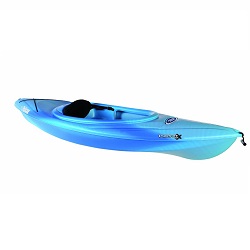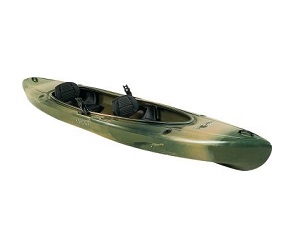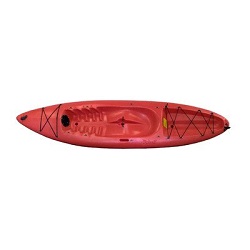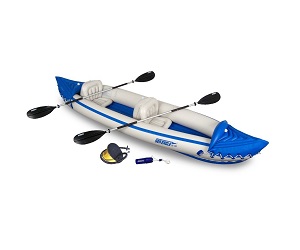If you want to get the most use out of your kayak, you will need to spend some giving it a little TLC and maintenance. The best reason to take good care of your kayak is safety. Weather can change for the worse in literally minutes and you don’t want to be stuck in the middle of the lake with a broken rudder or paddle.
You should spend some time maintaining your boat each season, especially in the spring and fall. It is important to clean and inspect the kayak each time you head out on the water. In addition, you will want to check the hardware and fittings before any big trips. Below you can find a seasonal maintenance schedule and checklist so your kayak will always be well cared for.
What You’ll Need:
- Paste wax (composite kayaks)
- 303 Aerospace Protectant (polyethylene kayaks)
- Mild soap or detergent
- Zipper lubricate
Spring Kayak Preparation
- Check all hardware, lines and bungees
- Repair any broken hardware, lines and bungees
- Apply zipper lube to rudder or skeg pivot, cables, housing, pedal or slider
- Apply 303 Aerospace Protectant to polyethylene kayaks
- Apply paste wax to composite kayaks
Set up a pair of sawhorses and place your kayak on top. Examine your kayak carefully and be sure to inspect the hardware, perimeter lines and bungees. The harmful UV rays that beat down on the kayak when it’s on the water can break down plastic padeyes and cause weakness in bungees so check and make sure they don’t need to be replaced. A bungees can be fixed with some silicone adhesive or hot glue followed by some electrical wire tubing.
If your kayak contains a rudder or a skeg, be sure to examine these carefully. Check the deployment lines, stainless steel cables, pivot hardware and cables and make sure they are all functioning properly. Clean the pivot points and pedals and spray lubricant down the cables to make sure everything works smoothly without any squeaks.
All kayaks manufactured out of plastic will develop scratches and dents. If a gouge has caused the plastic to stick up, you can shave down the plastic with a razor blade to make it smooth. This purely cosmetic and is not a required part of maintaining your kayak.
A deep scratch in a composite kayak can be polished smooth again and a fiberglass worker can patch holes and fix dents if required.
Another important part of spring maintenance is protecting the kayak from harmful UV rays radiated by the sun. An automotive wax is a good option for a composite kayak while 303 Aerospace Protectant works well for a polyethylene kayak. Be sure to apply the sun protectant each spring, before you head to the lake and reapply it often throughout the season.
Spring Maintenance for Paddling Gear
- Examine the paddle for damage and apply a silicone spray-lube to the joints
- Apply 303 Aerospace Protectant to PFD, spray skirt, wetsuit, neo hatch covers and gloves
- Spray zipper lubricant to anything with a zipper
- Resupply the first-aid kit and bailout bag
Fall Kayak Maintenance
- Wash boat inside and out with mild detergent
- Inspect hull and deck for damage
- Loosen rudder pedal straps, hatch straps
- Store in cradle with hatches loosely covered
After a fun summer on the water, it may be tempting to throw your kayak into the back of your garage and forget about it until next spring, however, fall is the most important time to perform maintenance on her. It’s time to set up the sawhorses again. Place your kayak upside down on the sawhorses and start by cleaning it. Fill up a bucket with boat cleaner and water. Spray water through the cockpit and into all the hatches using a hose. This will loosen sand, dead bugs and invasive marine life that has collected in the little crevices. It is illegal in most states to carry invasive species on your boat so make sure you spray down your kayak every time it leaves the water.
Once the kayak is sparkling clean, inspect the kayak and complete any repairs. You may decide to wait until spring to complete the repairs but knowing what repairs are needed can help you plan for next season.
Loosen the tension on all pedals, straps and bungees so they will retain their elasticity. Undo any buckles and remove hatch covers. Attach nylon window screens to the cockpit opening and hatches using rubber bands. This allows air to get into the kayak while keeping critters out.
Store your kayak on rigid brackets or slings made of nylon straps. There are plenty of kayak storage options available on Amazon. If you are using a wall bracket, make sure it is aligned with the bulkhead of your yak, where the hull is the strongest.
Fall Maintenance for Paddling Gear
- Examine and repair any damage to paddles, pumps or paddle floats. Apply lube where needed.
- Dry, examine and repair the PFD, skirt, wetsuit, neo hatch covers and drybags.
- Apply 303 Aerospace Protectant to drytop gaskets and store in cool dry place with open zippers.
- Throw away perishables from first-aid kit and bailout bag.
To get your gear ready for winter storage, you will need to clean it. The paddle bilge pump and paddle float need to be washed with mild detergent, dried and checked carefully for damage. Hand-wash your PFD, spray skirt, wetsuit, gloves, hatch covers and drytops in your bathtub with neoprene shampoo. Other gear should be washed with mild detergent. If anything smells really bad, try using an odor eliminator such as neoprene shampoo. Other gear should be washed with mild detergent. If anything smells really bad, try using an odor eliminator such as Revivex Odor Eliminator.
Check all paddling gear for damage and repair it. Make sure you check all zippers and straps. The drysuit’s latex gaskets should be coated with 303 Aerospace Protectant. You can also apply the protectant to other gear but it is not really needed if the gear is to be stored in a dark garage. Store all paddling gear and clothing in a cool, dark place with zippers open.
Go through your first-aid kit and bailout bag and throw away or remove anything that could go bad such as food, energy bars or batteries.
Now you can spend the holiday season relaxing with friends and family knowing that your gear will be ready and waiting for you next spring.




